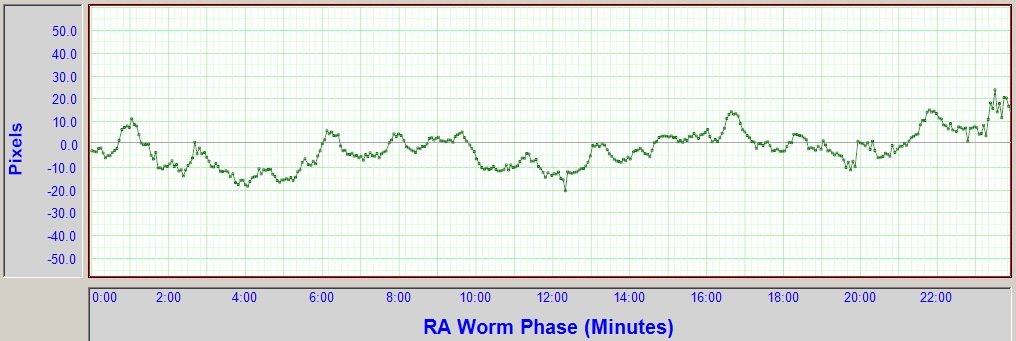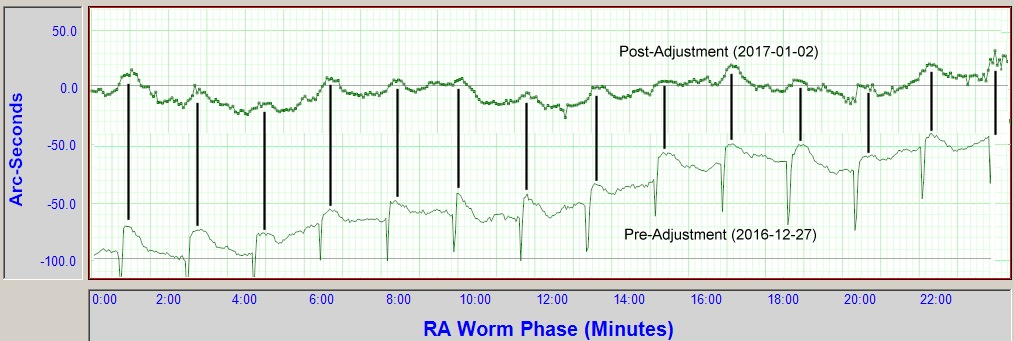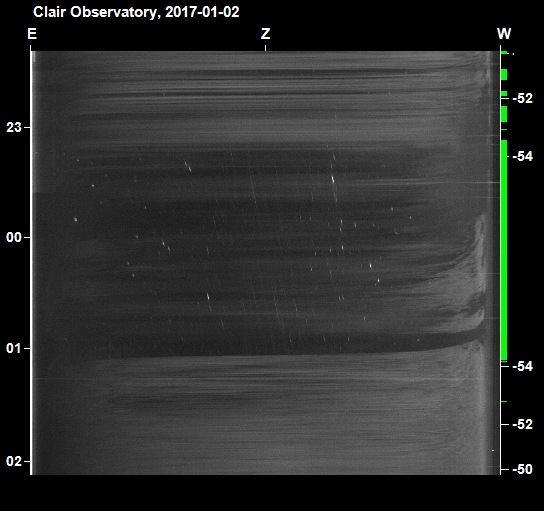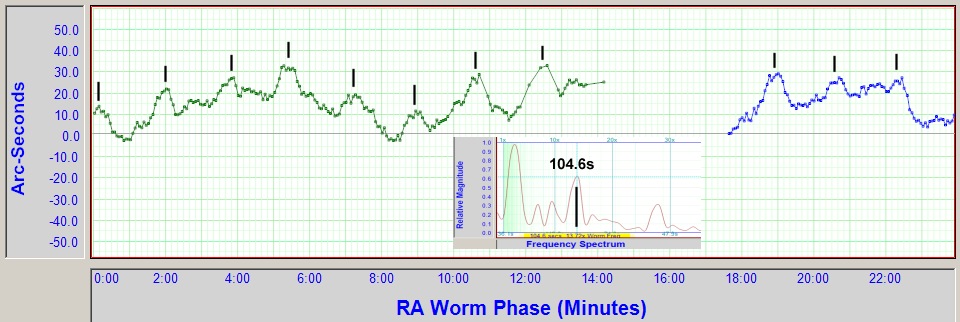David's Astronomy Pages
Notes - Session 598.3 (2017-01-02)
Notes
(S598.2)
Notes
Main
Home
Page
Notes
(S599.1)
David's Astronomy Pages
|
Notes (S598.2) |
Notes Main |
Home Page |
Notes (S599.1) |
2017-01-01 Observatory Software Issues (2017-01-01) 2017-01-02 Periodic Error Assessment (2017-01-02) PHD2 Guiding Software (2017-01-02) 2017-01-08 Periodic Error Assessment (2017-01-08)
During an attempted session on 2017-01-01 (abandoned due to passing rain showers), a number of non-critical but annoying software problems were encountered. These are described below along with their solutions (these problems occur every so often and recording the solutions here may save time the next time they are encountered.
Aurora Cloud Sensor
Problem:
The Cloud Sensor software loads and runs, but it's usual status/graph window can
not be seen on the screen.
Cause: The xy coordinates of the last
window position in the configuration file "CloudSensorUser.cfg" in the
software's program folder
C:/Program Files (x86)/Aurora Eurotech/Cloud Sensor/ have somehow become
corrupted with a negative numbers, causing the window not to be displayed on the
desktop.
Solution: Replace "CloudSensorUser.cfg" with a
copy of CloudSensorUser_orig.cfg (or other backed up copy of the user
configuration file). Alternatively edit "CloudSensorUser.cfg"
to show the following.
[Display]
OffsetX=640
OffsetY=284
SizeX=500
SizeY=500
(Note: Windows OS may not allow Edit operation unless run as Administrator)
Oregon WMR180 Weather Station
Problem: USB Hub for the Weather Station does not
connect to Base Station when the House Computer is switched on, which prevents
weather station data from being read by the Virtual Weather Station program
(VWS). This prevents remote monitoring of weather and prevents recording of
session weather on the Observatory laptop.
Cause: USB hub somehow loses its
ability to sychronize with the Base Station
Solution: On the Base Station
press and hold the UP and DOWN buttons together. Then, press the SEARCH button
on the USB Hub.
When the red LED light on the USB Hub is contiunously on, the
Base Station and Hub are synchronised and weather data information should then
be accessible by the VWS Program.
UltraVNC
Problem: Toolbar popups (used to display list of
shortcuts for astronomy folders and application etc) are not visible when
UltraVNC has a live connection, making it more difficult to operate the laptop
in the observatory from the PC in the house.
Cause:
Alpha Blending (required to display semi transparent windows of this type) is
not being captured on the server.
Solution:
The solution suggested online is to check "Capture Alpha Blending' option in
UltraVNC Server Admin Properties ('Misc' section), unfortunately the option is
not shown in my installation of UltraVnc.
Workaround:
Minimise all windows and seek out shortcut on the desktop or navigate to the
required folder/file using explorer.
Back to Top
Following adjustment of LX200's RA worm drive tension spring on 2016-12-29 that was designed to fix regular (~ 105s period) clicking noises with associated 30-50 arc sec jumps in RA when tracking at sidereal rate, post-adjustment tracking error data was collected using PemPro v2.8. This was performed on a star close to declination 0 and at an azmiuth of around 190 degs azmiuth where strong clicking noises with large RA jumps had previously been recorded (earlier data).
The new data showed that clicking sounds and large RA jumps seem to have gone
leaving just normal size errors (+/- 20 arc sec over 24 minute worm period .
However there is the continued presence of smaller 10-13 arc sec bumps in RA
every 104.2 secs. There is still a technical concern as these RA
bumps occur with a non-integer number of cycles per worm period (i.e. 13.78
cycles). I can't see how I can successfully eliminate this periodic error using
PEC since the RA bumps on one worm cycle do not occur at the same phase as the
RA bumps in subsequent worm cycles. There presence also interfers with normal PE
data collection/analysis.
[ Normal fundamental
frequences for a 12" LX200R(GPS) scope are 478.69s, 179.51s, 71.8s, 28.72s
& 9.57s ]
A further attempt to balance the telescope will be made after which fresh RA tracking data will be acquired and analysed (see here).
RA drift during the first first worm period was relatively small (just 20-25 arc secs or so over 24 minutes), however it increased significantly during a second period (reaching 200 arc sec over 24 minutes). It doesn't seem this large increase can be caused by Polar Alignment Error (though that could be contribution). There is greater noise in the second cycle due to increase in wind speed and decreased transparency (from thin cloud), but it doesn't seem that this could be responsible for the increased drift. Is the increase in drift related to 'tipping over' a telescope balance point (where un-balanced weight of the SBIG camera/filter/AO is suddently felt more strongly over the right (west) fork arm, whilst it was felt more evenly beforehand, or is related to non-uniformity in the big RA gear (e.g. in the eccintricty of the near but not perfectly circular gear).
| PemPro plot showing Tracking Errors in RA Drive (2017-01-02,
First Worm Cycle), This is after RA Worm Drive Tension Spring adjustement. The new data seems to show normal sized errors (+/-20 arc secs over 24 minute worm period). This is a combination of periodic error related to worm period, errors due to seeing & wind noise and a distinct periodic error that is unrelated to the worm period |
 |
| Comparison on new and old Tracking Errors (2017-01-02 vs 2016-12-27) Whilst the former sharp jumps in RA are no longer present in the new data there is still a periodicity present with smaller 10-13 arc sec bumps every 104 secs or so. |
 |
| Comparison of RA drift between Worm Cycles 1 & 2 (2017-01-02) RA Drift of 20-25 arc sec on first 24 minute cycle increases to 200 arc sec in the second 24minute cycle. (The 104 sec period appears to be less pronounced in Cycle 2) |
 |
| RA drift across Worm Cycles 1 & 2 (2017-01-02) RA Drift increasing from 20-25 arc sec in first 24 minute cycle to 200 arc sec in the second 24minute cycle. Additional noise in second worm cycle is due to an increase in wind speed around 00:45h plus a general decrease in sky transparency. |
 |
| AllSky Summary Plot covering the period 00:20 to 01:10h UT (=GMT) |
 |
Back to Top
| PHD2 Connect Equipment |

|
Back to Top
Following the addition of extra weight to the 12" LX200R scope in order to balance it in both front/back and left/right directions, a new was made to collect enough PE data (> 3 worm cycles) to produce a valid PEC curve. The attempt was twice foiled by the encroachment of cloud which caused the tracked star to be lost. Data from the two incomplete runs continue to show the presence of the regular 10-13 arc sec bumps in RA every 104.6 secs or so. This frequency (13.73 times per worm period) is a non-integer number which means this regular error can't be removed using PEC.
| PemPro plot showing Tracking Errors in RA Drive (2017-01-08, Run
1) Run aborted due to cloud (lost star). |
 |
| PemPro plot showing Tracking Errors in RA Drive (2017-01-08, Run
2) Run aborted due to cloud (lost star). |
 |
Back to Top
| This Web Page: | Notes - Session 598.3 (2017-01-02) |
| Last Updated : | 2017-01-27 |
| Site Owner : | David Richards |
| Home Page : | David's Astronomy Web Site |